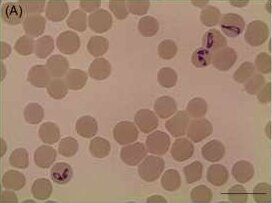Babesia caballi
Babesia caballi is a protozoan parasite that infects horses and other equids, leading to the disease known as equine piroplasmosis. This condition is characterized by fever, anemia, weight loss, jaundice, and in severe cases, death. Babesia caballi, along with Theileria equi, is one of the two main causative agents of equine piroplasmosis, a disease that poses significant challenges to the equine industry worldwide due to its impact on the health and performance of infected animals.
Life Cycle[edit | edit source]
The life cycle of Babesia caballi involves two hosts: a vertebrate host (horses, donkeys, mules) and an invertebrate host, typically ticks of the genus Rhipicephalus. The parasite is transmitted to horses through the bite of infected ticks. Once inside the horse, Babesia caballi infects red blood cells, leading to their destruction and resulting in the clinical signs associated with the disease.
Transmission[edit | edit source]
Transmission of Babesia caballi primarily occurs through tick bites, with Rhipicephalus (Boophilus) microplus being one of the most common vectors. However, the parasite can also be spread through the use of contaminated needles, syringes, or surgical instruments, and through blood transfusions from infected to uninfected horses.
Diagnosis[edit | edit source]
Diagnosis of equine piroplasmosis caused by Babesia caballi is typically based on clinical signs, serological tests (such as the complement fixation test or ELISA), and molecular techniques like PCR, which can detect the presence of the parasite's DNA in the blood of infected animals.
Treatment and Control[edit | edit source]
Treatment of Babesia caballi infection involves the use of specific antiprotozoal drugs, such as imidocarb dipropionate. Control measures include tick control strategies, quarantine and testing of imported horses, and in some cases, culling of infected animals to prevent the spread of the disease.
Epidemiology[edit | edit source]
Babesia caballi is found in many parts of the world, including Europe, Asia, Africa, and the Americas. The distribution of the disease is closely linked to the presence of competent tick vectors, which are influenced by climatic and environmental conditions.
Public Health and Economic Impact[edit | edit source]
While Babesia caballi does not infect humans, its impact on the equine industry can be significant. The disease can lead to trade restrictions for horses from endemic areas, and the cost of treatment, along with the potential loss of valuable animals, can be economically burdensome.
This veterinary-related article is a stub. You can help WikiMD by expanding it.
Search WikiMD
Ad.Tired of being Overweight? Try W8MD's physician weight loss program.
Semaglutide (Ozempic / Wegovy and Tirzepatide (Mounjaro / Zepbound) available.
Advertise on WikiMD
|
WikiMD's Wellness Encyclopedia |
| Let Food Be Thy Medicine Medicine Thy Food - Hippocrates |
Translate this page: - East Asian
中文,
日本,
한국어,
South Asian
हिन्दी,
தமிழ்,
తెలుగు,
Urdu,
ಕನ್ನಡ,
Southeast Asian
Indonesian,
Vietnamese,
Thai,
မြန်မာဘာသာ,
বাংলা
European
español,
Deutsch,
français,
Greek,
português do Brasil,
polski,
română,
русский,
Nederlands,
norsk,
svenska,
suomi,
Italian
Middle Eastern & African
عربى,
Turkish,
Persian,
Hebrew,
Afrikaans,
isiZulu,
Kiswahili,
Other
Bulgarian,
Hungarian,
Czech,
Swedish,
മലയാളം,
मराठी,
ਪੰਜਾਬੀ,
ગુજરાતી,
Portuguese,
Ukrainian
Medical Disclaimer: WikiMD is not a substitute for professional medical advice. The information on WikiMD is provided as an information resource only, may be incorrect, outdated or misleading, and is not to be used or relied on for any diagnostic or treatment purposes. Please consult your health care provider before making any healthcare decisions or for guidance about a specific medical condition. WikiMD expressly disclaims responsibility, and shall have no liability, for any damages, loss, injury, or liability whatsoever suffered as a result of your reliance on the information contained in this site. By visiting this site you agree to the foregoing terms and conditions, which may from time to time be changed or supplemented by WikiMD. If you do not agree to the foregoing terms and conditions, you should not enter or use this site. See full disclaimer.
Credits:Most images are courtesy of Wikimedia commons, and templates Wikipedia, licensed under CC BY SA or similar.
Contributors: Prab R. Tumpati, MD

